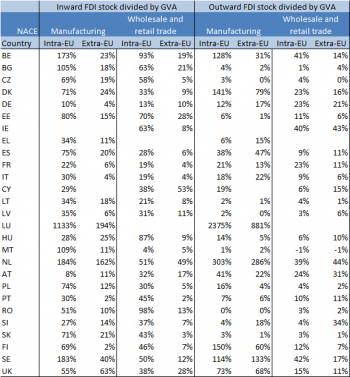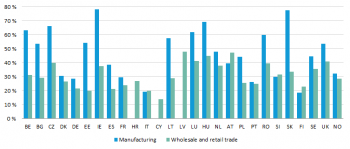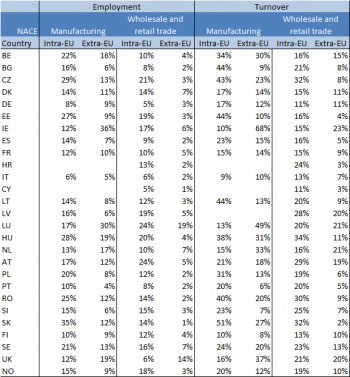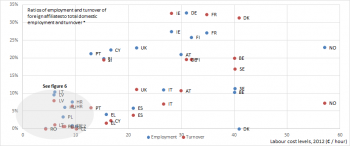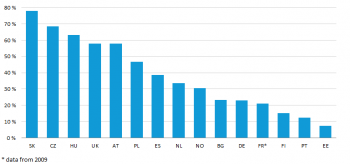Archive:Economic globalisation indicators in industry, wholesale and retail trade
- Data extracted in March 2015 Further Eurostat information, Main tables and Database.
In June 2014 Eurostat published a statistics explained article describing the construction of a set of economic globalisation indicators. Eurostat has extended this set of indicators along two dimensions. Firstly the indicators are calculated separately for intra-EU and extra-EU partners and secondly the indicators are calculated separately for 12 NACE Rev. 2 sections of the non-financial business economy. This article shows graphs and figures for nine of the indicators in two NACE sections (Manufacturing and Wholesale and retail trade), illustrating the type of information which could be used to track the different aspects of globalisation.
Main statistical findings
- Economic globalisation plays a large role in the Manufacturing and Wholesale and retail trade sectors of the EU. Indicator values in these two sectors are considerably higher than in the EU economy as a whole.
- Economic globalisation is more important for intra-EU partners than for extra-EU partners, showing the importance of the internal market.
- Imports and exports shares of GVA are larger for smaller economies than for larger economies that in general have more resources and therefore less need for international trade.
- For most countries the ratio of exports to imports show that there is a postive trade balance in Manufacturing and an negative trade balance in Wholesale and retail trade.
- Foreign controlled enterprises shares in total domestic turnover are almost always higher than shares in total employment, implying higher turnover per employee than in domestically controlled enterprises.
- Foreign affiliates' ratios of employment and turnover to domestic employment and turnover are generally higher in countries with high labour costs.
- The highest shares of foreign controlled R&D expenditure in total domestic R&D expenditure are found in member states that joined the EU in 2002 or later for intra-EU partners whereas for extra-EU partners these shares are higher in older member states.
There are of course exceptions to these findings and at the same there are many other aspects influencing globalisation such as history, infrastructure, human capital, tax rules, wages and business climate etcetera, but these fall outside the scope of this article.
Economic globalisation is important in Manufacturing and Wholesale and retail trade
In the previous article on economic globalisation: "International trade, investment and employment as indicators of economic globalisation") we described globalisation for the economy as a whole. The article showed the growing importance of globalisation for the European economy. In this article we will discuss the importance of globalisation in two specific economic sectors, namely Manufacturing and Wholesale and retail trade.
In table 1 the weighted averages of the globalisation indciators are presented for these two sectors. The table shows that economic globalisatioin is very important in these two sectors. The levels are substantially higher than those found for the economy as a whole. Comparing the two sectors to each other we find for all but one of the indicators higher values in Manufacturing than in Wholesale and retail trade.
International trade in goods
Table 2 shows the exports and imports of goods divided by GVA and the ratio of exports to imports by country. At first sight it seems strange to find ratios of more than 100% in exports and imports divided by GVA. However there is nothing unusual because GVA is calculated using net exports (exports – imports). Thus whenever exports and imports are large compared to domestic consumption, investment and government expenditure, these indicators can very well have values of more than 100%.
When we compare intra and extra EU figures for exports and imports we see that almost always the intra-EU figures are higher than the extra-EU figures underlying the importance of the internal market. The few exceptions are Greece, Spain, Malta, Finland and the United Kingdom although not all combinations of exports/imports and manufacturing/trade. They all tend to be on the outskirts of the EU and therefore are likely to have important extra-EU trading partners.
Comparing manufacturing to wholesale and retail trade we see a clear difference in the export and import figures of these sectors. Manufacturing typically has larger shares in exports but in Wholesale and retail trade typically the shares in imports are larger than in exports. A possible explanation is that in Manufacturing, countries in the EU tend to import relatively cheap raw materials and intermediate products while exporting more expensive final products.
The combined effect of lower imports and higher exports in Manufacturing gives most countries a positive trade balance whereas in Wholesale and retail trade the opposite is true. This can clearly be seen in the last four columns of the table where exports are divided by imports, mostly giving values higher than 100% for Manufacturing and lower than 100% for Wholesale and retail trade.
Foreign direct investment
The foreign direct investments from and to EU countries divided by GVA are shown in table 3. Just as for imports and exports of goods, we find for that intra-EU investments divided by GVA are generally higher than extra-EU. This is more prominent in inward investments than in outward investments. Comparing FDI between Manufacturing and Wholesale and retail trade we see that in general FDI as a percentage of GVA is bigger in Manufacturing than in Wholesale and retail trade. This seems to be especially the case for larger economies with the exception of Germany.
When comparing inward and outward investments we see that for most countries intra-EU inward investments are larger than outward investments whereas for extra-EU it is the more often the other way around.
Differences between small and large economies give a more mixed picture for FDI than they do for imports and exports. As expected large economies such as France, Germany and Italy have low ratios of FDI stocks to GVA but other large economies such as Spain and the United Kingdom have fairly high ratios. It is not clear whether these differences are due to economic phenomena or due to regulatory differences between countries.
Employment and turnover in foreign controlled enterprises
An enterprise is under foreign control when another enterprise abroad owns, directly or indicrectly, 50% or more of the shares. Figure 1 and 2 respectively show the share of employment and turnover to domestic employment and turnover in foreign controlled enterprises. The pattern for both is obviously quite similar; countries that have high shares of employment in foreign controlled enterprises also have high shares of turnover in foreign controlled enterprises. For almost all countries the shares are higher in Manufacturing than in Wholesale and retail trade, and when the opposite is true the differences are small.
When comparing employment and turnover shares we see that in almost all cases turnover shares are higher than employment shares. In Manufacturing only in 2 out of 24 countries for intra-EU partners and in 1 out of 24 countries for extra-EU partners the opposite is ture . In Wholesale and trade we only find 3 out of 22 countries for intra-EU partners and none for extra-EU partners where this is the case. Since both are shares of total domestic employment and turnover this implies a higher turnover per person employed for foreign controlled enterprises than for domestic controlled enterprises.
In table 3 the shares have been broken down by intra-EU and extra-EU. As for the other indicators we see that in most countries both employment and turnover in foreign controlled enterprises have higher values for intra-EU than for extra-EU partners . For the few countries where the opposite is true we see that the differences are quite small for Germany and Italy but noticeable for Ireland, Luxembourg and the Netherlands (both intra-EU and extra EU) and the United Kingdom (only intra-EU).
Employment and turnover in foreign affiliates
In contrast to foreign control where the controlling enterprise is abroad and controls a domestic enterprise there can also be a domestic enterprise controlling a foreign enterprise. In that case the controlled enterprise is said to be a foreign affiliate. For these indicators we saw earlier in table 1 that size is not be an important factor in determining the shares. In figure 3 (for Manufacturing) and figure 4 (Wholesale and retail trade we have plotted the shares of employment and turnover against the labor cost level. In Manufacturing we find the highest shares for Luxembourg (too high for the graph), the Scandinavian countries and United Kingdom followed by France, Germany and Austria. These countries also have a high labor cost level. In Wholesale and retail trade there are mostly the same countries that have high shares and high level of labour cost. Exceptions are Norway which has low shares compared to its high labour cost level and Slovenia with relatively high shares considering its labor cost level. Likely this indicates that it is not just the countries own labour cost level but also the labor cost level of neighbouring countries that influences the shares.
In table 4 we have broken down the shares for extra-EU and intra-EU partners. Again we find only a few exceptions to the facts that globalisation plays a bigger role in Manufacturing than in Wholesale and retail trade. When comparing intra-EU and extra-EU we see that in Wholesale and retail trade more countries have higher intra-EU values than extra-EU. For Manufacturing this is also the case for turnover but not for employment.
Research and development (R&D) in foreign controlled enterprises
R&D statistics of foreign controlled enterprises are collected for the NACE-sections B to F of the non-financial business economy which does include Manufacturing (section C) but not Wholesale and retail trade (section G). Therefore we only show the indicators for Manufacturing in figures 5.
Shares vary a lot between countries, we find share of over 60% but also shares of under 20%. Some relatively small economies such as for Slovakia, Czech Republic and Hungary have high values whereas other small economies such as Finland, Portugal and Estonia are the three countries with the lowest values. Of the larger European economies we see that Germany and France have relatively low shares of around 20% whereas the United Kingdom has a share that is relatively high (58%) with Spain (39%) in between.
In figure 6 the figures have been broken down by intra-EU and extra-EU partners and the data for 2009 has been added. The three countries with the highest share in intra-EU expenditure in 2011 (Slovakia, Czech Republic, Hungary) are member states that joined the EU in 2002. In contrast in extra-EU expenditure among the four countries (United Kingdom, Netherlands, Slovakia and Austria) with the highest share, three are older member states. All of the countries that joined EU in 2002 or later have higher shares in intra-EU expenditure than in extra-EU expenditure. In the older member states some countries have higher shares in extra-EU expenditure (Netherlands, Portugal, Finland, United Kingdom ) but others have not (Austria, Germany, Spain and France).
Further Eurostat information
Publications
- Foreign affiliates statistics - employment by business function
- Microdata linking - international sourcing
- International sourcing of business functions
- International_trade, investment and employment as indicators of economic globalisation
- International sourcing statistics
- Global value chains - international sourcing to China and India
- Features of International Sourcing in Europe in 2001-2006 - Statistics in focus 73/2009
- International Sourcing in Europe - Statistics in focus 4/2009
- Plans for International Sourcing in Europe in 2007-2009 Statistics in focus 74/2009
Dedicated section
Methodology / Metadata
- Foreign affiliates of EU enterprises - outward FATS (ESMS metadata file — fats_out_esms)
- Foreign controlled EU enterprises - inward FATS (ESMS metadata file — fats_esms)
- European Union direct investments (ESMS metadata file — bop_fdi_esms)
- International trade (ESMS metadata file — ext_esms)
Source data for tables, figures and maps (MS Excel)
Other information
- Commission communication COM/2010/0612 final Trade, Growth and World Affairs Trade Policy as a core component of the EU's 2020 strategy - European Commission, 2010


